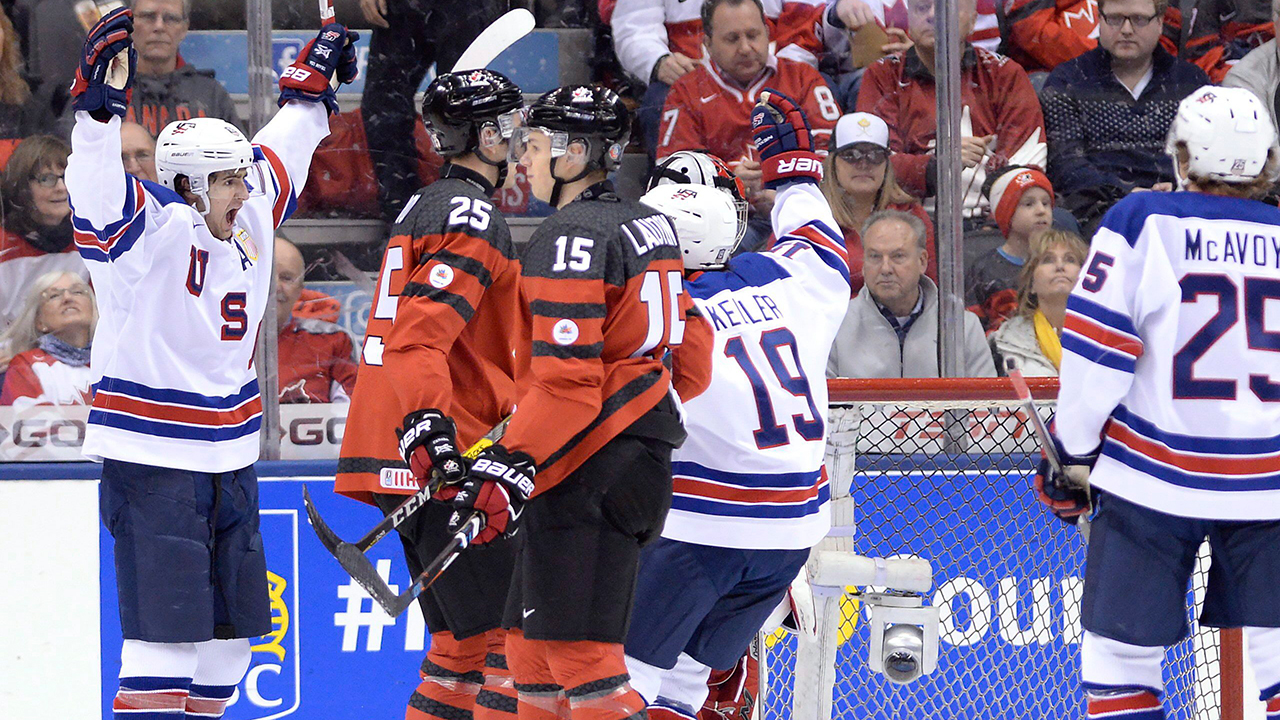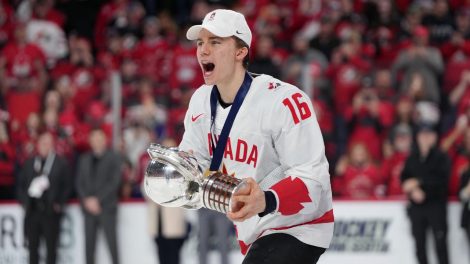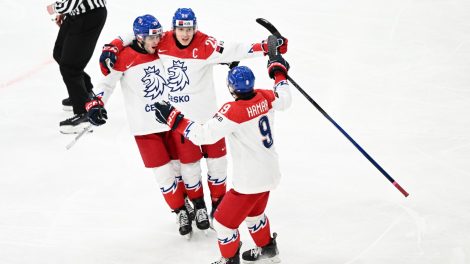TORONTO — About four minutes into the second period of Saturday afternoon’s clash between Canada and the United States, Canadian defenceman Philippe Myers carried a puck behind his own net. He looked to his right as American forward Jeremy Bracco closed in on him and backhanded the puck along the boards for a teammate in order to avoid imminent contact from the fore checker.
What the defenceman didn’t see coming was American captain Luke Kunin, who tore behind the net from Myers’ left and threw a hit that didn’t go so much into Myers as it did through him. The Canadian crashed to the ice, his stick clutched under his arm as he held his hands up to his head. A long 10, maybe 15 seconds passed before Myers slowly picked himself up, doubling over at the waist as he delicately skated directly to his dressing room. He did not return.
It’s a concussion—one that will definitely hold Myers out of Canada’s next game on Monday and very likely keep him out of the rest of this tournament. And that, friends, is the most critical Canadian fallout from Saturday afternoon’s game, a chippy contest that ended in a 3-1 American victory.
From a placement perspective, the loss itself is far from severe. Canada will now play the Czech Republic in the quarterfinals and be lined up for a semifinal clash with Sweden, assuming the Tre Kronor get through a quarterfinal against the fourth-place team in pool B. Canada was probably going to have to beat Sweden at some point to win this tournament—now they’ll just have to do it sooner rather than later.
But losing Myers is massive. The tall defenceman has been one of Canada’s best players at the tournament and is one half of the team’s dominant top defence pairing along with Thomas Chabot. Kale Clague took his place for the second half of the game and you can expect seventh defenceman Jeremy Lauzon to see an expanded role as well, but Myers isn’t exactly the kind of player that is easily replaced.
It’s a tough blow. But it’s rare that teams go wire-to-wire at a tournament like this without some sort of injury adversity. Canada will hope this is the end of it for them, and that they can tighten up the other flaws that led to their New Year’s Eve defeat. We’ll cover that and much more in your Canada vs. USA takeaways.
Ingram gets the start
Canadian head coach Dominique Ducharme has managed his goaltending on a game-by-game basis throughout the tournament, saying he and his coaching staff discuss the performance of each netminder in depth after every game and adjust their future plans accordingly. So, that’s how Connor Ingram ended up getting the start Saturday afternoon, after Carter Hart earned a leisurely win against Latvia two days prior.
Ingram was solid if not spectacular against the Americans, stopping 23 of 26 shots and not giving up any easy goals. The Kamloops Blazer made one of the game’s biggest saves late in the second period, when he snared a Joey Anderson shot on a clean breakaway. And he made another breakaway stop early in the third, kicking away a Patrick Harper attempt when the American forward came racing in alone. A goal on either of those breakaways could have completely sucked the life out of Canada in the game’s latter stages.
So, what happens now? Hart and Ingram have played two games apiece—one against a good team (Russia for Hart, the U.S. for Ingram) and another against a not-so-good team (Latvia for Hart, Slovakia for Ingram). Hart has looked shaky at times, allowing a few soft goals from long distances, but he was also believed to be the Canadian coaching staff’s preferred option coming into the tournament. Ingram, on the other hand, was barely tested in a six-shot shutout against Slovakia and played fine enough against the U.S. but didn’t blow anyone away.
No one has been able to get a read on where Ducharme is going with his goaltending in this tournament, and that will likely remain consistent until Monday morning when he has to name a starter for that night’s quarterfinal. Ingram has looked better than Hart and is certainly battle tested after the U.S. game, so he could be a natural choice to lead Canada into the elimination round. But it wouldn’t be a surprise to see Ducharme go back to Hart, either. No matter which goaltender he chooses, you can be sure their play will be extremely—perhaps preposterously—scrutinized. Canada loves to eat its goalies.

On the latest podcast, Gare Joyce from Toronto and Eric Engels from Montreal join the guys to talk all things world juniors.
Listen now | iTunes | Podcatchers
Disciplinary matters
Penalties continued to be an issue for Canada, as both of the infractions they committed in the first period led to U.S. goals. Neither penalty was especially egregious—Tyson Jost was called for goalie interference after being shovelled into the crease by an American defender and Myers went off for tripping after an awkward body check—but the fact the U.S. capitalized on their opportunities so quickly shows just how fine the disciplinary line can be.
American dynamos Cody Keller and Jordan Greenway were instrumental to both goals. Canada struggled to keep up with the playmaking of Keller, who set up both tallies, and to deal with the physical play of Greenway, who scored the second goal from directly in front of the Canadian net.
And that was all the U.S. needed—two power-play goals scored within the first six minutes. That has to be especially frustrating for the Canadians considering how extremely competitive the game was when the teams were at even strength.
Canada has now been shorthanded 19 times in four games, the second-most in the tournament. And although they had killed off all but one of their penalties coming into Saturday’s game, it didn’t take much of a hockey savant to note that giving up so many power plays would catch up to them—especially as the quality of their opposition improves.
The power play goes quiet
Playing with a man advantage had been a significant strength for the Canadians, who came into Saturday’s game with a tournament-best eight goals on 14 opportunities. But an assertive U.S. penalty kill put an end to that, defending aggressively, throwing themselves in front of numerous Canadian shots, and getting a plethora of timely saves from goaltender Joseph Woll, who probably should have been their player of the game.
Canada spent a quarter of the second period on the power play but struggled to generate offence and finished the night with just one power-play goal on six opportunities. It took a two-man advantage in the second for Canada to get that goal, as a blocked Dylan Strome shot careened directly onto the stick of Chabot, who buried his first of the tournament.
At that point it was 2-1, and Canada tried its best to capitalize on their momentum. The next phase of even-strength hockey was played at a whirlwind pace, as both teams traded chances up and down the ice. But the Canadian push came to a halt 13 minutes into the period when Ingram gave up a big rebound off a point shot that ended up on the blade of Bracco who buried the third U.S. goal.

Not a scout? No worries. Jeff Marek’s newest podcast is all you need.
Listen now | iTunes | Podcatchers
The first true test
The U.S. presented a much different style of play than any team Canada has faced to this point, pushing the pace and checking aggressively. The Americans had two goals before Canada even recorded a shot and frustrated the hosts with an aggressive forecheck that ate up space and disrupted zone entries.
There was also a testiness to this game that Canada had yet to experience. Greenway and Julien Gauthier jawed with each other prior to the opening faceoff, the first stoppage of play featured a lively scrum in front of the Canadian net, and as the night wore on, pushing and shoving was an assurance at each stoppage in play.
Canada certainly didn’t shrink from that challenge, but they didn’t rise above it either. Matthew Barzal, Canada’s player of the tournament so far, had a quiet afternoon, as did Taylor Raddysh, who scored four times against Latvia.
At one point in the third period, Ducharme juggled his lines in search of a catalyst, shifting Tyson Jost onto the top unit along with Strome and Michael McLeod. That sent Dubois down on to a line with Gauthier and Nicolas Roy that didn’t see much ice time in the third.
It’s probably harsh to call the Canadian effort flat, but it was definitely a tick below the Americans who played with great energy and blocked a truly remarkable amount of shots. Canada can expect to meet a bit less resistance in their quarterfinal against the Czechs, who they overwhelmed in a pre-tournament game, 5-0. But there will be no easy games after that, and Canada will have to match the energy and aggression of their opponents going forward.









